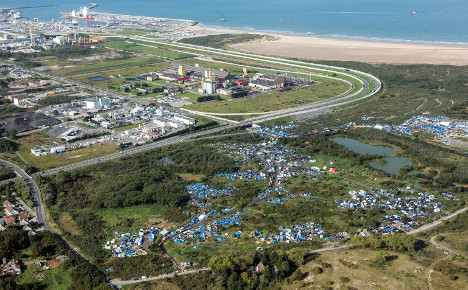History tells us the 'Great Wall of Calais' is not fit for purpose

The Great Wall of Calais, the giant barrier that the UK is to build in order to keep the Jungle's refugees and migrants at bay will not achieve its aims argues academic Sean Lang in The Conversation.
Sean Lang, Senior Lecturer in History at Anglia Ruskin University explains why the one-mile long, four metre high wall that Britain will build to prevent migrants from gaining access to UK-bound trucks will do more harm than good.
Incredibly, 27 years after the world celebrated the fall of the detested Berlin Wall, barriers are back in fashion. Donald Trump has promised to build a wall along the Mexican frontier to keep those pesky Mexicans out – though they will, he blithely assumes, happily pay for it– and now the UK’s home secretary, Amber Rudd, has announced that Britain will pay for a wall to keep back the refugees of the Calais “Jungle”.
Defensive walls to keep undesirables out are nothing new – 2,000 years ago, the Great Wall of China was built to keep the “barbarian” Mongols at bay. It didn’t work – they worked their way round it and ended up ruling China. Hadrian’s famous wall marked the northernmost frontier of the Roman Empire, but the tribes who brought the Empire crashing down came instead from Germany. Oops.
 (Hundreds of migrants spill onto the road
(Hundreds of migrants spill onto the road
Walls are about control – rulers use them to set boundaries beyond which law, protection and people may not go. They isolate and separate, turning former neighbours and friends into a dangerous and untrustworthy “Other”. So the Nazis built walls across the cities of eastern Europe to create Jewish ghettos, making normal community relations impossible and turning Jews from next-door neighbours or work colleagues into “the people on the other side of the wall”.
Of course, this approach can backfire: the Berlin Wall inadvertently turned West Berlin into a highly attractive but unattainable island of Western prosperity in the heart of the Communist bloc. It also provided both John F Kennedy and Ronald Reagan with their most celebrated anti-Soviet soundbites, which certainly wasn’t what the East Germans had intended when they built it.
Even walls with a less deadly purpose can feel oppressive. One of the most hated features of pre-revolutionary Paris was the Wall of the Farmers-General, a customs barrier that surrounded the city and lined the pockets of France’s tax farmers, officials who were entitled to a substantial share of the taxes they collected. It symbolised the privilege enjoyed by the French aristocracy and, not surprisingly, was one of the first structures torn down by the Paris mob in the Revolution.
Intriguingly, in 19th century India, the British built a similar customs barrier, in the form of a vast and impenetrable hedge, ten to 14 feet high and six to 12 feet thick, stretching from the Indus to the Mahanadi in Madras – a distance of 2,300 miles – to stop evaders of their salt tax. It was completed in 1869 and took 14,000 labourers to build – and was patrolled by nearly the same number of troops. Ten years after it was built, the customs line was abolished and today there are hardly any traces left of the Great Hedge.
For such highly visible signs of control, governments are surprisingly reluctant to admit their walls' real purposes. Officially, the Berlin Wall was a defensive structure to protect the people of East Berlin from Western fascism, though its real purpose, as everyone knew, was to keep them in. Israel’s controversial concrete barrier around the Palestinian-inhabited areas of the West Bank was erected to protect Israelis from terrorist attacks during the second Intifada but its critics accuse Israel of using it to contain and control the Palestinians themselves.

Wall in the mind
It is tempting to say that walls are doomed to fall. To the younger generation, the Berlin Wall is probably better known for falling than for going up and everyone knows how the walls of Jericho came “tumblin' down”. Certainly the mighty walls of Christian Constantinople were unable to prevent the city’s conquest by the Turks in 1453. Hadrian’s Wall, which was originally much higher and more substantial than the remains we see today, may have been intended to overawe the Pictish tribes but it could not protect Roman Britain from collapse. History is littered with the remains of these brick or concrete assertions of control.
But the impact of walls should not be underestimated. The Berlin Wall helped to embed the idea in German minds that they were two peoples, not one. In the difficult times that followed reunification in 1990, Germans from both sides of the country sometimes complained that they wished the Wall could go back up again.
The sealed border between the two Koreas has acted as a wall so effectively that it is easy to forget that the Koreans were ever one people. By separating people, walls prevent that immediate human contact that can challenge stereotypes and develop understanding and compassion. If you want people to forget their common humanity, keep them divided by walls and prevent them from ever meeting.
In this way, the Calais wall may have an impact far beyond the security concerns that have led to its creation. Walls on their own won’t protect lorries from people determined to get to Britain, but they can keep both French and British people away from the migrants themselves and help entrench still further the idea of “us” and “them” that Nigel Farage whipped up in the EU referendum. Once that idea is implanted in people’s minds, it can prove a much stronger and more durable wall than any made of brick or concrete.
This article was first published on the website The Conversation.
Comments
See Also
Sean Lang, Senior Lecturer in History at Anglia Ruskin University explains why the one-mile long, four metre high wall that Britain will build to prevent migrants from gaining access to UK-bound trucks will do more harm than good.
Incredibly, 27 years after the world celebrated the fall of the detested Berlin Wall, barriers are back in fashion. Donald Trump has promised to build a wall along the Mexican frontier to keep those pesky Mexicans out – though they will, he blithely assumes, happily pay for it– and now the UK’s home secretary, Amber Rudd, has announced that Britain will pay for a wall to keep back the refugees of the Calais “Jungle”.
Defensive walls to keep undesirables out are nothing new – 2,000 years ago, the Great Wall of China was built to keep the “barbarian” Mongols at bay. It didn’t work – they worked their way round it and ended up ruling China. Hadrian’s famous wall marked the northernmost frontier of the Roman Empire, but the tribes who brought the Empire crashing down came instead from Germany. Oops.
 (Hundreds of migrants spill onto the road
(Hundreds of migrants spill onto the road
Walls are about control – rulers use them to set boundaries beyond which law, protection and people may not go. They isolate and separate, turning former neighbours and friends into a dangerous and untrustworthy “Other”. So the Nazis built walls across the cities of eastern Europe to create Jewish ghettos, making normal community relations impossible and turning Jews from next-door neighbours or work colleagues into “the people on the other side of the wall”.
Of course, this approach can backfire: the Berlin Wall inadvertently turned West Berlin into a highly attractive but unattainable island of Western prosperity in the heart of the Communist bloc. It also provided both John F Kennedy and Ronald Reagan with their most celebrated anti-Soviet soundbites, which certainly wasn’t what the East Germans had intended when they built it.
Even walls with a less deadly purpose can feel oppressive. One of the most hated features of pre-revolutionary Paris was the Wall of the Farmers-General, a customs barrier that surrounded the city and lined the pockets of France’s tax farmers, officials who were entitled to a substantial share of the taxes they collected. It symbolised the privilege enjoyed by the French aristocracy and, not surprisingly, was one of the first structures torn down by the Paris mob in the Revolution.
Intriguingly, in 19th century India, the British built a similar customs barrier, in the form of a vast and impenetrable hedge, ten to 14 feet high and six to 12 feet thick, stretching from the Indus to the Mahanadi in Madras – a distance of 2,300 miles – to stop evaders of their salt tax. It was completed in 1869 and took 14,000 labourers to build – and was patrolled by nearly the same number of troops. Ten years after it was built, the customs line was abolished and today there are hardly any traces left of the Great Hedge.
For such highly visible signs of control, governments are surprisingly reluctant to admit their walls' real purposes. Officially, the Berlin Wall was a defensive structure to protect the people of East Berlin from Western fascism, though its real purpose, as everyone knew, was to keep them in. Israel’s controversial concrete barrier around the Palestinian-inhabited areas of the West Bank was erected to protect Israelis from terrorist attacks during the second Intifada but its critics accuse Israel of using it to contain and control the Palestinians themselves.

Wall in the mind
It is tempting to say that walls are doomed to fall. To the younger generation, the Berlin Wall is probably better known for falling than for going up and everyone knows how the walls of Jericho came “tumblin' down”. Certainly the mighty walls of Christian Constantinople were unable to prevent the city’s conquest by the Turks in 1453. Hadrian’s Wall, which was originally much higher and more substantial than the remains we see today, may have been intended to overawe the Pictish tribes but it could not protect Roman Britain from collapse. History is littered with the remains of these brick or concrete assertions of control.
But the impact of walls should not be underestimated. The Berlin Wall helped to embed the idea in German minds that they were two peoples, not one. In the difficult times that followed reunification in 1990, Germans from both sides of the country sometimes complained that they wished the Wall could go back up again.
The sealed border between the two Koreas has acted as a wall so effectively that it is easy to forget that the Koreans were ever one people. By separating people, walls prevent that immediate human contact that can challenge stereotypes and develop understanding and compassion. If you want people to forget their common humanity, keep them divided by walls and prevent them from ever meeting.
In this way, the Calais wall may have an impact far beyond the security concerns that have led to its creation. Walls on their own won’t protect lorries from people determined to get to Britain, but they can keep both French and British people away from the migrants themselves and help entrench still further the idea of “us” and “them” that Nigel Farage whipped up in the EU referendum. Once that idea is implanted in people’s minds, it can prove a much stronger and more durable wall than any made of brick or concrete.
This article was first published on the website The Conversation.

Join the conversation in our comments section below. Share your own views and experience and if you have a question or suggestion for our journalists then email us at [email protected].
Please keep comments civil, constructive and on topic – and make sure to read our terms of use before getting involved.
Please log in here to leave a comment.